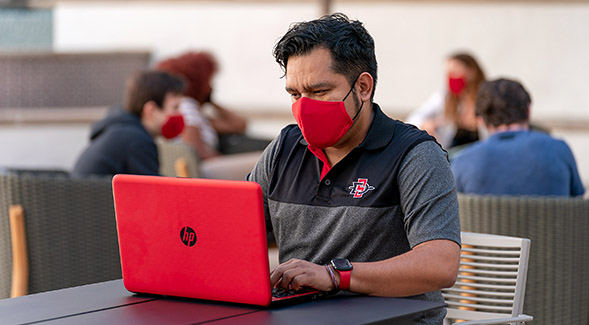One Year Later and Closer to a Different Future
One year after SDSU moved most employees and students off campus during the rise in COVID-19 cases globally, the university is planning for a different fall.

Within mere days in mid-March 2020, San Diego State University’s highly energetic and busy campus became quiet and still following a global rise in COVID-19 cases and a series of public health decisions restricting in-person activities.
On March 17, 2020, SDSU officials announced that public access to campus would be restricted and the majority of faculty and staff would work remotely, following the move to virtual instruction and reduced on-campus student housing.
To commemorate one year of change and loss, and to honor the memory of the more than 2.65 million people who have died around the world due to COVID-19, SDSU will lower its flags to half-staff on Wednesday and light the Conrad Prebys Aztec Student Union tower on Wednesday, March 17.
As the campus community reflects on the last year while looking toward a more hopeful future given the emergency rollout of three new COVID-19 vaccines, the SDSU NewsCenter team acknowledges the work of university faculty, staff, students and administrators over the last year.
With support from parents, families, alumni and donors, the university has never closed and, throughout the pandemic, has introduced new research initiatives, support services, virtual and also in-person programming respecting ongoing public health orders.
These are just a few of the many examples of what members of the SDSU community created, completed or continue to sustain in the interest of individual well-being, community health and the preservation of the university’s teaching and research missions:
Mitigating the Spread
- Student Health Services (SHS) launched a program to both assess COVID-19 cases to determine interventions while offering expansive student testing. To date, SHS has administered more than 25,000 COVID-19 tests to students.
- The university launched a public health awareness campaign, which included a public-facing site and a COVID-19 Weekly Digest with news, updates and information about both COVID-19 mitigation efforts and whole health tips.
Protecting the Community
- A facial covering mandate was issued for all those on campus as a critical first line of defense in mitigating the spread of COVID-19, and other illnesses. The facial covering requirement remains in effect on campus.
- As an additional option for eligible faculty, staff and students, SHS pursued and gained approval to administer COVID-19 vaccines on campus. To date, SHS has offered more than 800 COVID-19 vaccine doses to those deemed eligible by state and county officials.
- The School of Nursing launched an effort, currently ongoing, to train more than 300 nursing students to help administer the COVID-19 vaccine in San Diego County.
New Ideas and Solutions
- University researchers and scholars have generated more than $8.6 million in funding for COVID-19-realted projects, to include: examining the relationship between loss of smell and taste and COVID-19; developing practices for testing and also measuring SARS-CoV-2 in wastewater; a comprehensive resource database to help monitor and visualize outbreak patterns in San Diego County using big data, GIS and social media; investigating synergies between tuberculosis, COVID-19 and AIDS, and their rates of transmission; addressing students stopping out of school due to the pandemic by encouraging college student engagement; and creating a model to address the impact of COVID-19 on current school counselors, among many other projects and initiatives.
- “Communities Fighting COVID!” was launched through a $5 million National Institutes of Health grant to improve testing in underserved communities, including the Latinx community.
- Through a partnership with the County of San Diego Health and Human Services Agency (HHSA), SDSU public health faculty received nearly $3 million to recruit and train community health workers and students through an extensive contact tracing program.
Whole Health and Community Care
- The university hired several new Counseling and Psychological Services staff members in spring 2021 to directly serve students.
- The Campus Assistance, Response, Engagement & Support (CARES) Team was launched to connect students with direct, one-on-one assistance for academic, financial, technological, psychological and other needs.
As we look to fall 2021, SDSU’s current campus plans and projections indicate that the university will appear much different than it has since March 2020. More in-person courses and in-person activities will be offered, with thousands more students planned to live in on-campus housing. Also, more faculty and staff will be working physically on campus.



